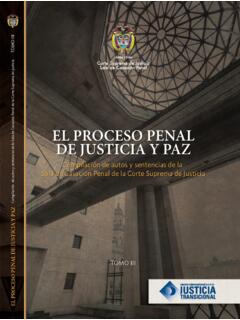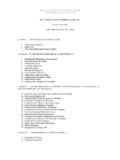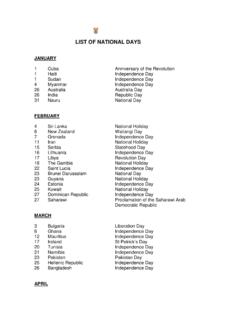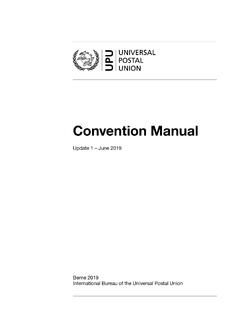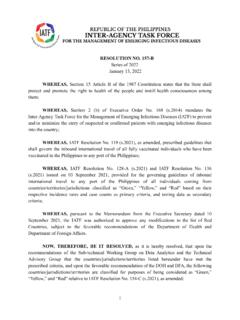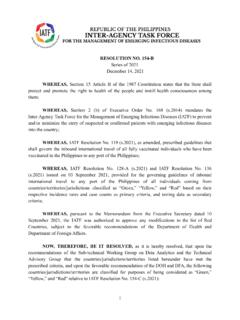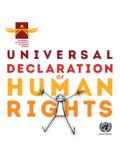Transcription of A Brief History of Liberia - International Center for ...
1 A Brief History of Liberia Peter Dennis The International Center for Transitional Justice May 2006 Early History Liberia was founded in 1822 as an outpost for returning freed slaves from the Americas. It grew into a colony and eventually became a commonwealth, and achieved independence in 1847 with the help of the American Colonization Society (a private organization based in the United States). Descendants of the freed slaves, generally known as Americo-Liberians, remained in social and political control of the country until 1980. The unequal distribution of power and wealth resulting from Liberia s social structure is largely at the Center of the recent conflicts: In 1923, Abayomi Karnga, a scholar and politician of recaptive parentage, noted that the status divisions among the Liberians eventually evolved into a hierarchical caste system with four distinct orders.
2 At the top were the Americo-Liberian officials, consisting largely of light-complexioned people of mixed Black and White ancestry [also known as Mulattos ]. They were followed by darker skinned Americo-Liberians, consisting mostly of laborers and small farmers. Then came the recaptives [also known as Congos 1], the Africans who had been rescued by the Navy while aboard slave ships and brought to Liberia . At the bottom of the hierarchy were the indigenous African As time passed, the separation between the Mulattos and other freed slaves became less pronounced, and all became known as Congos or Americo-Liberians. This group of individuals, comprising less than 3 percent of the population, maintained economic, social, and political control of the country until a coup d etat in 1980. 1980: End of Americo-Liberian rule Liberia began to change during the 1970s.
3 In 1971, William Tubman, Liberia s president of 27 years, died while in office. Tubman s Open Door economic policy brought a great deal of foreign investment at heavy price, as the divide widened between the prospering Americo-Liberians (benefiting from such investment) and the rest of the population. Following Tubman s death, his long-serving vice president, William Tolbert, assumed the presidency. Because Tolbert was a member of one the most influential and affluent Americo-Liberian families, everything from cabinet appointments to economic policy was tainted with allegations of nepotism. 1 Because many the recaptives were originally from the Congo River region of Africa, they were called Congos. For much of Liberia s early History , the Congos were classed below the Americo-Liberians. However, over the years the two groups joined and the terms Americo-Liberian and Congo were used interchangeably.
4 2 Robin Dunn-Marcos et al., Liberians: An Introduction to Their History Culture, Culture Profile No. 19, The Center for Applied Linguistics, April 2005. However, Tolbert was also the first president to speak an indigenous language, and he promoted a program to bring more indigenous persons into the government. Unfortunately, this initiative lacked support within Tolbert s own administration, and while the majority felt the change was occurring too slowly, many Americo-Liberians felt it was too rapid. In April 1979, a proposal to raise the price of rice (which the Tolbert administration subsidized) met with violent opposition. The government claimed that the price increase was meant to promote more local farming, slow the rate of urban migration, and reduce dependence on imported rice. However, opposition leaders also pointed out that the Tolbert family controlled the rice monopoly in Liberia and therefore stood to prosper.
5 The ensuing rice riots severely damaged Tolbert s credibility and increased the administration s vulnerability. In April 1980, Army Master Sergeant Samuel Doe, an ethnic Krahn, led a coup d etat that resulted in Tolbert s murder and the public execution of 13 of his cabinet members. Among the many Liberians that fled the country was then Minister of Finance, Ellen Johnson-Sirleaf. 1980 1984: The People s Redemption Council After the coup, the People s Redemption Council (PRC), headed by Doe, assumed power and suspended the Constitution. Doe lacked formal education; by many accounts he was illiterate at the time he took over the presidency. He also had no political or leadership experience. After only one year, Doe concerned that his leadership was being threatened from within the PRC executed his vice dead of state and comrade in the 1980 coup, Thomas Weh-Syen, along with four other PRC members, claiming they had plotted against him.
6 From this point on, Doe appeared increasingly paranoid regarding threats to his leadership and, as a result, his government became dominated by members of his own Krahn ethnic group. Much of the population that initially supported the transition from Americo-Liberian rule became increasingly disenfranchised as the government returned to monopolized control. In November 1983, three of Doe s influential colleagues in the PRC left Liberia : Thomas Quiwonkpa (Commanding General of the Armed forced of Liberia ), Charles Taylor (Head of the General Service Agency), and Prince Yormie Johnson (aide to Quiwonkpa). All would eventually challenge Doe for control of the country. Facing increasing pressure from International organizations and donors, Doe lifted the ban on political parties and called for elections in 1985. 1985 1989: The National Democratic Party of Liberia The Liberian elections of October 1985 were problematic.
7 Few International (or local) observers felt they were conducted fairly. However, the United States endorsed the results (although the current State Department position is that the elections were characterized by by widespread fraud ). In the end, Samuel Doe was named victor over his closest opponent, Jackson F. Doe. However, many believed, and still maintain, that Jackson F. Doe won the election. The following month, Samuel Doe s former second-in-command, Thomas Quiwonkpa, entered Liberia through sierra Leone and attempted to topple Doe through another coup. Quiwonkpa failed, and his body was dragged through the streets of Monrovia. Doe s Krahn-dominated government retaliated against the ethnic groups in Quiwonkpa s native Nimba County, causing widespread loss of life within the Gio and Mano communities. Even though elections were scheduled to take place in 1991, the growing abuse within Nimba County provided a fertile opportunity for Charles Taylor (related to Quiwonkpa by marriage) and Prince Johnson (an ethnic Gio) to begin planning to overthrow Doe.
8 1989 1996: Civil War On December 24, 1989, Charles Taylor and a small group of Libyan-trained rebels entered Nimba County from neighboring C te d Ivoire. This group, the National Patriotic Front of Liberia (NPFL), initially encountered plenty of support within Nimba County, which endured the majority of Samuel Doe s wrath after the 1985 attempted coup. The Armed Forces of Liberia (AFL) launched counterattacks against Taylor s forces. The Economic Community of West African States (ECOWAS) peacekeeping force, ECOMOG, entered the conflict under the premise of a cease-fire and peace deal, albeit without the NPFL. The NPFL continued to make gains on the capital, Monrovia, and widespread atrocities were reported in Krahn and Mandingo areas. The Mandingoes were still largely victims of the NPFL onslaughts until 1991, when they, along with exiled Krahn, organized the United Liberation Movement for Democracy in Liberia (ULIMO).
9 While reports vary, it appears that Ellen Johnson-Sirleaf was affiliated with Charles Taylor s movement. In July 1990, Prince Johnson split from Taylor and formed the Independent National Patriotic Front (INPFL). The INPFL and NPFL continued their siege on Monrovia, which the AFL defended. In September 1990, Doe visited the ECOMOG headquarters in Monrovia, where officials urged him to accept exile outside of Liberia . At the time, ECOMOG was barely established in the Free Port of Monrovia. At the port, Doe was captured and taken to the INPFL s Caldwell base. The circumstances that led to Doe s visit to the Free Port are still unclear; however, after Doe arrived, Prince Johnson s INPFL attacked the headquarters and captured, tortured, and killed him. Johnson s INPFL and Taylor s NPFL continued to struggle for control of Monrovia in the months that followed.
10 In November 1990, ECOWAS negotiated a settlement and established the Interim Government of National Unity (IGNU), led by Dr. Amos Sawyer, a former dean of political science at the University of Liberia . However, Charles Taylor did not recognize the IGNU, and the fighting continued. The Krahn and Mandingo groups, often targets of the NPFL, formed ULIMO in 1991. In 1994 ULIMO split into two factions, ULIMO-J (mostly Krahn, led by Roosevelt Johnson) and ULIMO-K (mostly Mandingo, led by Alhaji Kromah). By 1995, Liberia s civil war had grown to include the following seven major factions: NPFL NPFL Central Revolutionary Council (NPFL-CRC) Lofa Defense Force (LDF) ULIMO-K ULIMO-J Armed Forces of Liberia (AFL) Liberian Peace Council (LPC) In September 1995, in accordance with the Abuja Peace Accords, the seven factions joined to form the Liberian Council of State.
